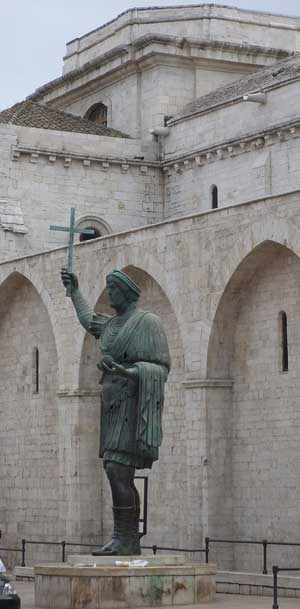About Barletta
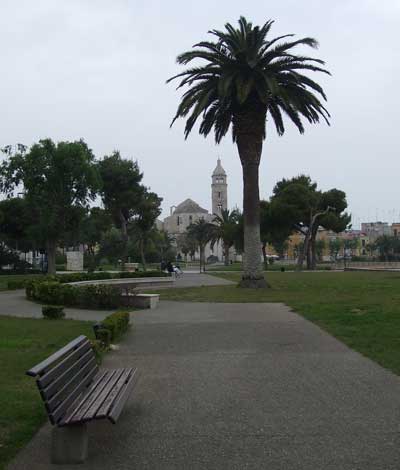
Barletta is a coastal town in Puglia, southern Italy, lying to the north of Bari on the Adriatic coast. It’s a pretty large place with a population of over 90,000, modern suburbs and a working port. Barletta isn’t a major halt on the tourist trail but it is a pleasant place to stop for lunch or for a stroll. The historic town centre is attractive, and its sights of interest include an ancient bronze ‘Colossus’ and an imposing fortress. There are sandy beaches to either side of the town centre which attract summer visitors. Barletta has excellent public transport links and is a few minutes by train from the more famous and attractive fishing town Trani.
Things to see in Barletta
Coming from the railway station (more directions below), the first major sights you see in Barletta are the Basilica del Santo Sepolcro, an imposing white church, and the bronze Colossus which stands outside, cross held aloft. The church (normally kept closed) was a rest-stop on the pilgrim and Crusader route to the Holy Land.
There are many different versions of the story of the Colossus of Barletta. It may be a statue of the Emperor Marcian which once stood on a column in Constantinople, was stolen by the Venetians, then shipwrecked and washed up on the shore at Barletta. Alternatively it could be a statue of some other Eastern Emperor, Theodosius II perhaps, brought from Ravenna by the cultured medieval ruler Frederick II. You can take your pick of the stories, because the statue, standing casually by the side of a busy street, isn’t telling. The legs and hands were rather clumsily replaced, but the 5-metre-high statue is still a powerful reminder of the later days of the Roman Empire, and said to be the largest surviving ancient bronze statue.
It’s worth spending a little time wandering the narrow medieval lanes of Barletta’s old town, the centro storico, where washing hangs out to dry and some buildings have stone benches incorporated into their walls so that residents can sit and pass the time of day. Beyond these huddled dwellings lie more open and elegant streets and some time-worn palazzi, testament to the town’s past wealth and importance.
Close to the castle at the edge of the centro storico is Barletta’s cathedral, the Cattedrale di Santa Maria Maggiore. The building combines Romanesque and Gothic features, and has seen some important moments in its past including a royal coronation. The adjacent belltower rises above an archway over the street. On the wall alongside are carved accounts of moments in the town’s past – pointed out to us by a local man cycling by.
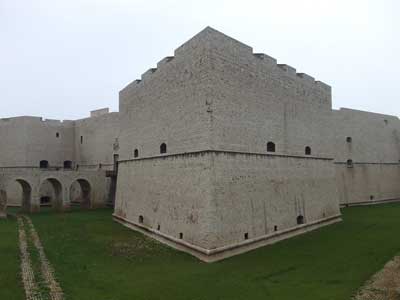
The Castello Svevo is the seat of the town museum, the Museo Civico e Pinacoteca (closed lunchtimes and Mondays), which has as a prize exhibit a bust of Frederick II. The castle, which is a massive, sprawling construction, is reached through a pretty park which rather mysteriously kept all but one of its gates locked when we visited. The fortress is very old, but its current appearance is mostly due to sixteenth-century reconstruction.
One of Barletta’s most famous natives was the impressionist painter Giuseppe De Nittis (1846-84). There is a museum dedicated to the artist – the Pinacoteca Giuseppe De Nittis – in Palazzo della Marra (Via Cialdini) which contains many of his works, left to the city after the death of his widow. The gallery is closed on Monday afternoons.
From the historic centre there is not much sense of being near the sea, and the winding lanes lack a picturesque seafront. If you wish to spend time on the beach, you will need to walk along busy streets some way to the east or the west, where there are expanses of sand and some of the usual Italian beach establishments.
The Disfida di Barletta
One of Barletta’s claims to fame is the rather ridiculous tale of the Disfida di Barletta (Challenge of Barletta), a 1503 duel between Italian and French knights to prove who were the true cowards after a Frenchman had insulted the Italians. Naturally, the Italians vindicated their honour, and the event is celebrated each year with re-enactments in February and again in the summer. The story is displayed on a board outside the Cantina della Disfida, reputedly the tavern which was the setting for the original insult. The building is decorated in period fashion and open to the public (closed lunchtimes and Mondays).
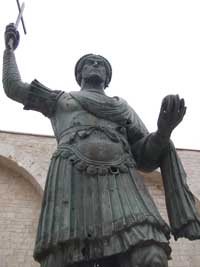
Barletta food, drink and practicalities
Barletta’s tourist information office is by the corner of Corso Garibaldi and Via Cavour. Like most attractions, it closes in the middle of the day for a long lunch. There are several places to eat in the centro storico, although visiting on a Monday we found many of them closed. The Caffè Vista on the pavement between the cathedral and the castle is a pleasant place to sit and enjoy a drink and a light lunch.
Barletta travel
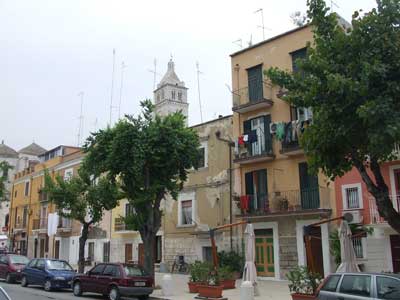
Barletta is a convenient transport hub. The town is connected to Bari by two railway lines – the mainline FS (Ferrovie dello Stato) national network which runs down the coast to Bari, stopping in Trani, and the inland commuter service run by the Ferrovie Nord Barese which passes through Andria and Ruvo di Puglia. Both services use the same railway station; the Ferrovie Nord Barese platforms are reached by the underpass which heads beyond the mainline platforms. The Ferrovie del Gargano run a bus service to Foggia. There are also bus services connecting local towns, such as Trani and Andria, run by STP. The nearest airport to Barletta is Bari Palese Airport. To reach the centro storico from Barletta railway station, take Viale Giannone opposite, cross the green public square and turn right along Corso Garibaldi.
Around Barletta
Barletta combines well in a day-excursion or a longer trip with some nearby destinations. By catching a train to Andria and then a bus (or by driving) you can visit Castel del Monte, Frederick II’s famous castle on a hill which is now a UNESCO site. Another short train ride away is Trani, which is a very attractive seaside town with a fishing harbour and a cathedral poised above the sea.
About seven miles from Barletta is the archaeological site of Canne della Battaglia (Canne of the Battle), the scene of Hannibal’s victory over the Romans. At the site there are remains of Roman paving and walls, and some medieval ruins. The settlement here was abandoned after its destruction by the Normans.
Accommodation
Barletta is a pleasant town, though it can be seen and appreciated in just a few hours. It probably loses out on overnight visitors to nearby Trani, which is a more obviously appealing overnight base, but Barletta’s transport links and beaches make it worth considering as a stopover.
Useful external links
Ferrotramviaria – Ferrovie Nord Barese (timetables are under orari)
